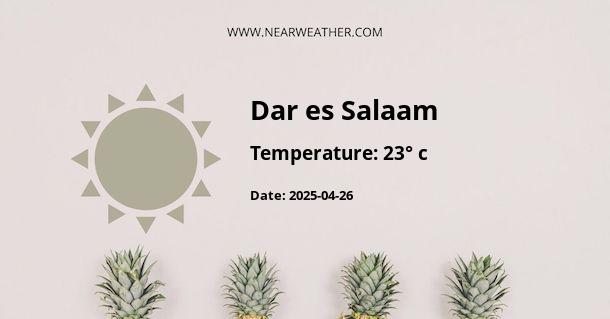Overview
Dar es Salaam is a vibrant city located in the eastern part of Tanzania, along the coast of the Indian Ocean. Known as the commercial and cultural hub of Tanzania, Dar es Salaam experiences a tropical savanna climate, typical of many coastal cities in Eastern Africa.
Climate and Weather Year Round
Climate Classification
Dar es Salaam falls under the Köppen climate classification of "Aw," which denotes a tropical savanna climate with a pronounced dry season. This classification is characterized by high temperatures throughout the year, with a more distinct variation in rainfall than in temperature.
Temperature
The city experiences a relatively constant temperature range throughout the year, with average high temperatures typically hovering around 30 to 32°C (86 to 89.6°F), and average low temperatures ranging from 20 to 23°C (68 to 73.4°F). The warmest month is usually February, while the coolest month is July.
Rainfall
Rainfall in Dar es Salaam is significantly varied, with two distinct rainy seasons. The long rains, or "Masika," occur from March to May, while the short rains, or "Vuli," take place from October to December. The driest period falls between June and September. The average annual rainfall is approximately 1,100mm.
Humidity
Due to its coastal location, the city experiences high humidity throughout the year, often exceeding 75%. The humidity levels can make temperatures feel hotter than they actually are, a phenomenon known as the heat index.
Seasonal Weather Patterns
Dry Season (June - September)
The dry season in Dar es Salaam is characterized by clear skies, less rainfall, and relatively cooler temperatures. This is often considered the best time to visit, as the lower humidity levels and absence of rainfall make for more comfortable conditions.
Long Rains (March - May)
The long rainy season is marked by heavy and consistent rainfall. During this period, the city experiences its highest levels of humidity. Despite the rain, temperatures remain high.
Short Rains (October - December)
During the short rainy season, the city experiences intermittent rainfall, often in the form of brief, intense showers followed by sunshine. The temperatures during this period remain warm, similar to the rest of the year.
Impact of Climate on Daily Life
The tropical savanna climate of Dar es Salaam impacts various aspects of daily life, from agriculture and water supply to tourism and urban planning. The rainy seasons are crucial for farming activities, while the dry season is a popular time for tourists. The city's infrastructure also has to be resilient to handle the heavy rainfall during the wet seasons.
Climate Change Considerations
Like many coastal cities, Dar es Salaam is vulnerable to the impacts of climate change, including sea-level rise and increased frequency and intensity of extreme weather events. Efforts are being made at various levels to mitigate these risks and adapt to changing conditions.
Conclusion
Understanding the climate and weather patterns of Dar es Salaam is vital for various sectors, including tourism, agriculture, and urban planning. The city's tropical savanna climate offers a unique combination of consistent high temperatures and variable rainfall, providing a distinctive living and visiting experience.
A - Dar es Salaam's Latitude is -6.823490 & Longitude is 39.269508.
A - Weather in Dar es Salaam is 23° today.
A - Climate Conditions in Dar es Salaam shows light rain today.
A - Humidity in Dar es Salaam is 96% today.
A - Wind speed in Dar es Salaam is 11.02 km/h, flowing at 216° wind direction. today.
